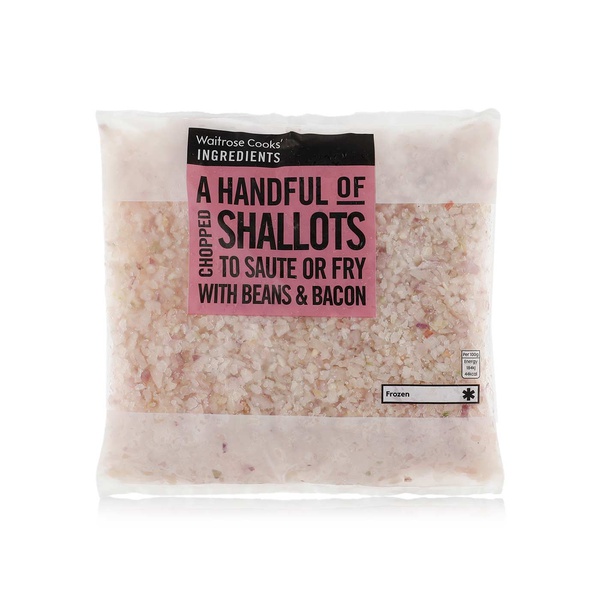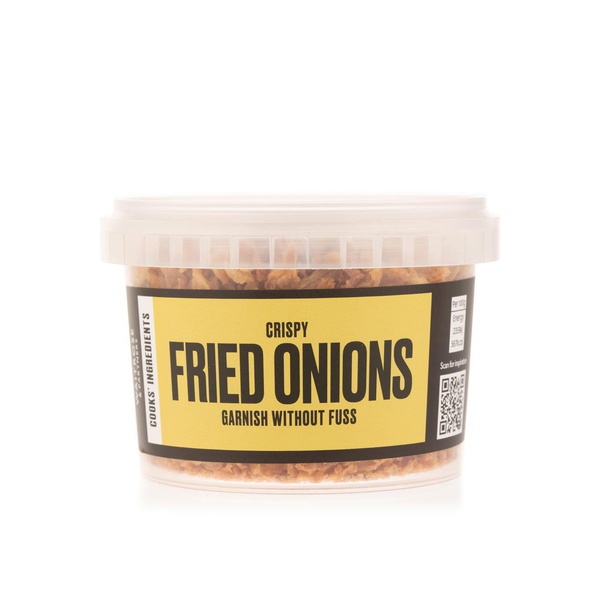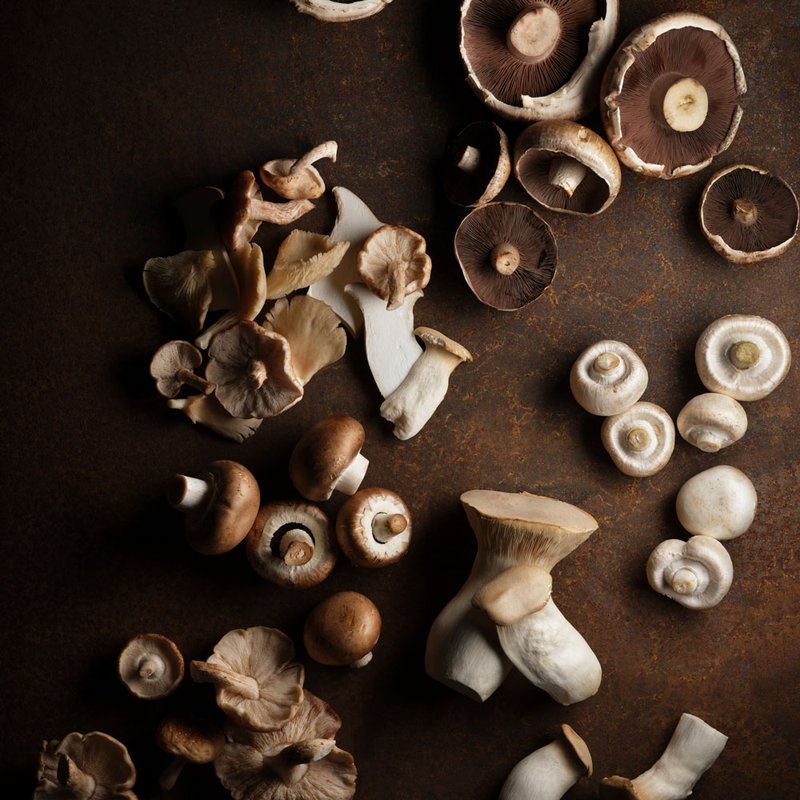Peeling back the layers
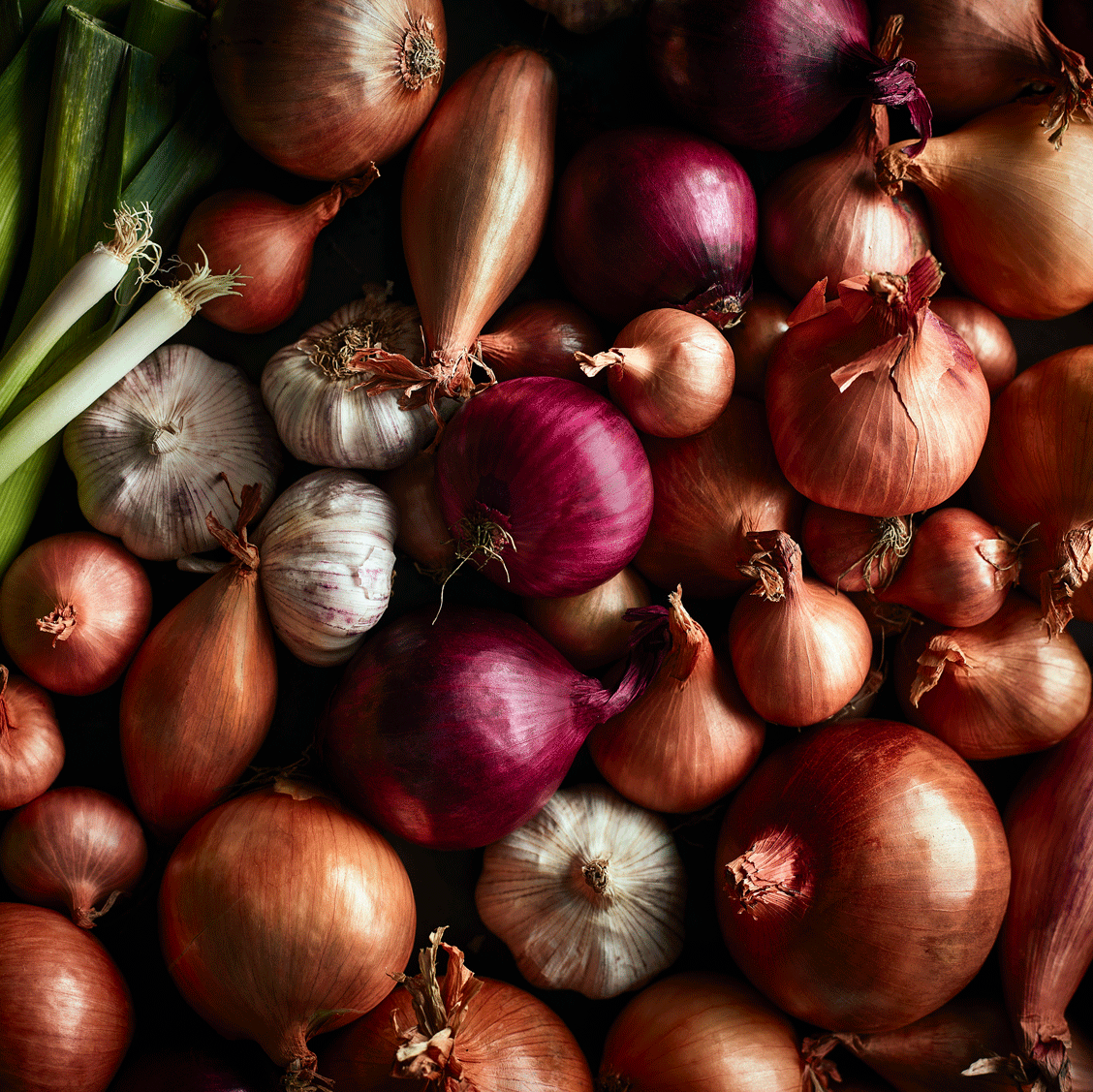
Across much of the world, from Asia to the Mediterranean, the first step in cooking is often to chop an onion and have a good cry. In Portugal for instance, many dishes begin with cooking down chopped onions and garlic, sometimes tomatoes, in olive oil for a sauce base called refogado. Cooking in Tuscany often starts with a battuto (literally ‘beaten’) made up of chopped onions with some carrots, celery, garlic, parsley and occasionally the raw bacon known as pancetta added. The Cajun food of Louisiana always commences with what is called the holy trinity: onions, celery and peppers. In North Indian and Mughlai cuisine, all sauces begin with onions.
It may be that one of the reasons for this is the way that a sautéed onion fills the kitchen with a warm, sweet, inviting fragrance that seems to promise delectable things to follow. The onion has always been a thing of mystery: though one of the least colourful vegetables, it has nevertheless been recognised as a worthy still-life subject by Renoir, Cézanne and van Gogh. And there is probably no other vegetable that has had so many poems written about it – from those of Francisco de Quevedo, the noted 17th-century poet of Spain’s Golden Age, who wrote of the onion with its ‘white scarves’, to the Chilean poet Pablo Neruda, who in his Odes to Common Things wrote: “The fragrance of the earth is alive in your crystalline nature.” Modernist poet William Carlos Williams had more modest praise for spring onions (Modernists are supposed to avoid extravagance), describing them as ‘a perfect appetizer’ when fried and served hot on rye bread.
The name onion comes from the Latin word union, which means single, because an onion has a single bulb as opposed to a cluster. Romans called onions unionem, which became unyon in Middle English, then onion or, in French, oignon. As a species they are mild unless attacked: most do not even have a strong smell. But bitten or cut, they retaliate. The toxic spittle they send out is sulphur-based, dissolving into the water of the eyes and turning into sulphuric acid, a nasty little trick designed for defence against mammals. Most stay away, but humans are undeterred. Our persistence is rewarded, because the sulphur-based compounds are easily transformed: heat, for example, completely changes them, which is why a cooked onion does not taste or smell or act anything like a raw one.
These pungent compounds are a characteristic of the genus Allium, which contains between 600 and 750 species – it’s been suggested that the word allium may come from a Celtic one meaning ‘strong flavoured’, or the Greek aleo, ‘to avoid’. As well as Allium cepa (onions) and Allium sativum (garlic), other members of the family include Allium schoenoprasum (chives, which can withstand heat and drought and also flourish in the frozen northern tundras of Alaska and Siberia) and Allium porrum (leeks). Most of the alliums known in the West seem to have begun in Central Asia and later found their way into China, but there are also Chinese originals – including bunching onions (Allium chinense), which are commonly pickled and eaten as a snack. Allium ursinum (the strong-smelling wild garlic, or ramson), features in a centuries-old Irish tradition: strips of it were placed in shoes to help with colds or coughs.
There has been a sense throughout history that onions themselves are tough and harsh things that need to be tamed, that they cause pain but are worth it. They have been symbolically bound up with both heroism and healing: in Homer’s Odyssey, Odysseus calls on the power of onions to gain him entry to Circe’s lair, and a few centuries later Hippocrates, considered the father of medicine, prescribed onions to prevent pneumonia, as a diuretic, and for healing wounds (before bacteria was fully understood, anything that seemed to fight off infection was thought to chase away evil; the idea that vampires are susceptible to garlic stems from an older myth that both garlic and onions drove off spirits). Onions were once the food of champions: the Olympic athletes of ancient Greece prepared for their contests by eating them, either for strength and power or for good fortune, and Alexander the Great had his armies eat onions because he thought their strong flavour signalled that they would make his troops strong.
In many parts of Europe, onions continue to be celebrated at folk festivals. One of the most cherished local varieties are calçots, grown in the Catalan region of Spain: as large as leeks but stronger-tasting, and white up to their green tips (their name means ‘stocking’, because they appear to wear a white one).
At free-spirited bashes known as calçotadas, the most famous of which is held in January, they are charcoal grilled, traditionally on grapevine branches saved after the wine harvest, then served hot on a terracotta roofing tile. The blackened skin is torn off, the onion is dipped in a special sauce, then it is popped into the mouth with one’s head leaning back to receive it. The most legendary participants get through several hundred calçots at a sitting – there are places where being a champion onion eater still counts.
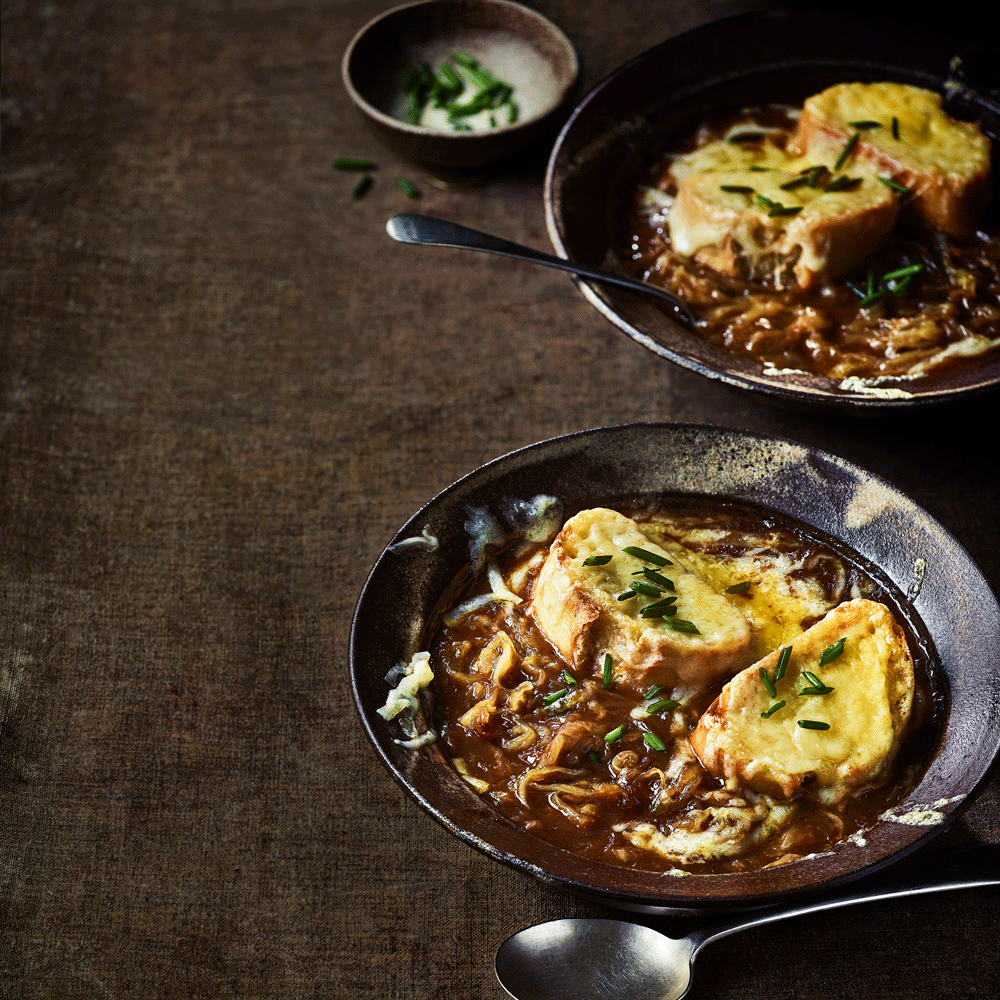
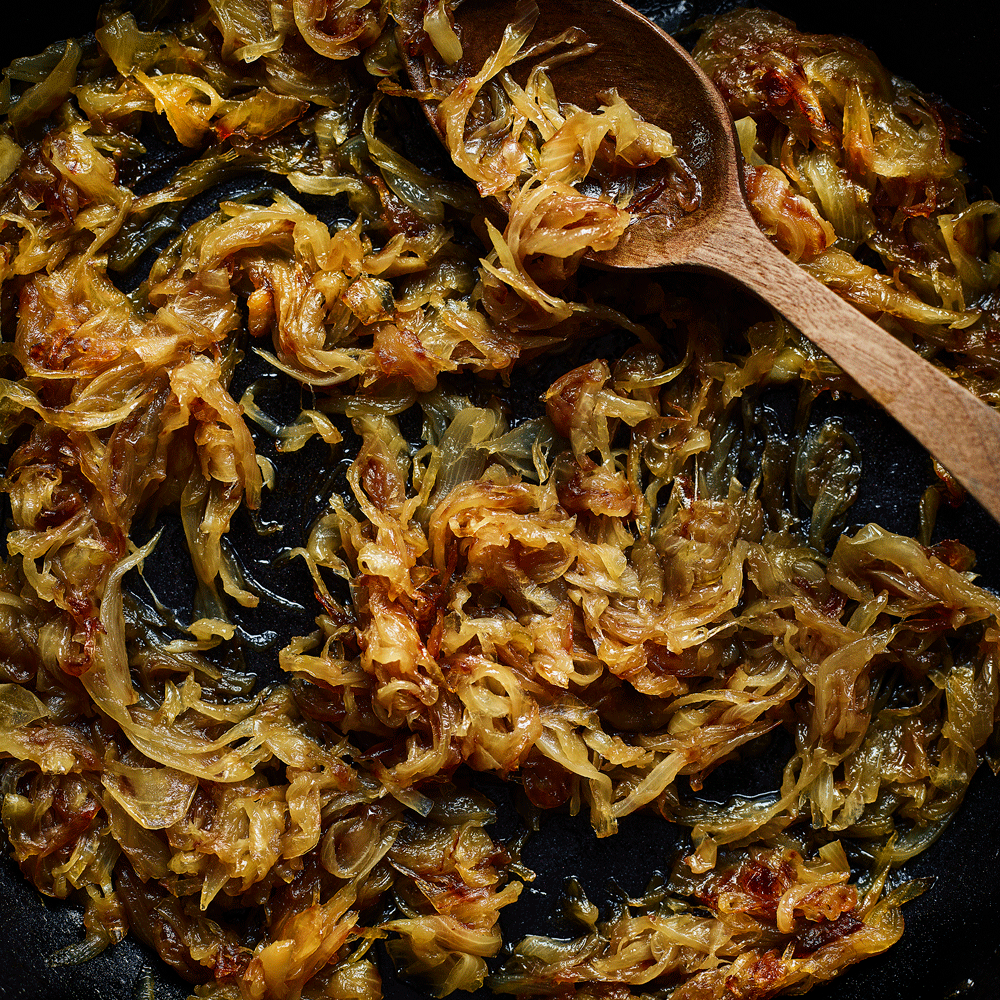
ONIONS
Not the showiest of vegetables but certainly one of the most versatile, onions are the beginning of almost everything delicious. Most braises, stews and, of course, soups begin with one. The most famous of all onion soups, with its bubbling cheese croutes, originated in Paris in the 19th century, but it’s been a mainstay since the Middle Ages.
The best caramelised onions
Makes about 500g; takes 40 minutes. Heat 2 tbsp oil and 30g unsalted butter in a large pan over a low-medium heat. Add 2 large onions, thinly sliced, with a pinch of salt and cook for about 10 minutes, stirring regularly, until softened and starting to colour. Turn the heat down to very low and continue to cook, stirring regularly, for about 30 minutes until the onions are golden. Tip into a wide serving bowl and allow to cool to room temperature.
How to store and use caramelised onions…
KEEP cooled caramelised onions in the fridge for up to 5 days or portion and freeze in a freezeproof bag or container for up to 2 months.
SWIRL through mayonnaise, soured cream and chives to make the moreish French onion dip, then top with gremolata.
LAYER caramelised onions on bread with plenty of grated cheese to make the ultimate cheese toastie.
ADD a spoonful to your tomato-based pasta sauce to help balance the acidity and bring a welcome sweetness. Caramelised onions are especially good with sausage pasta.
An ode to pickled onions
For many Brits of a certain vintage, the ultimate nostalgia-trigger food is a pickled onion. I’m talking about the kind that are lifted out of a glass jar in a seaside chip shop, the brine released by the first bite as bracing as salt spray.
Outside the UK, pickled onions are chic: the dinky French jarred ones are to charcuterie as the bikini was to Brigitte Bardot, while in the US they’re used to garnish drinks.
SALAD ONIONS
Also known as spring onions, these perky alliums can do virtually no wrong, cooked or raw. To turn them into a garnish, shred 6cm lengths into very thin strips and pop them in a bowl of iced water for 10 minutes – the straight ribbons will magically become spirals.
GARLIC
Ardent fans tend to adopt a more-is-more approach: Nigella Lawson’s recipe for chicken with 40 cloves of garlic is something of a modern classic. (The trick is to keep them in their skins as they cook.) Look out for black garlic, the striking dark colour and super-savoury flavour of which comes from it being slowly heated and aged. Try Cooks’ Ingredients Dark Black Garlic bulbs mashed into sauces for stir frying.
Can garlic really fight colds?
“Eat your greens,” practically every child is told. But “eat your alliums” would be equally good advice; in addition to making food taste great, they have real health-giving properties. Every one is packed with plant chemicals that have been shown to have a positive impact on your gut health as well as your heart and immune system.
Garlic, onions and leeks contain fibre that feeds ‘good’ gut bacteria. Some types of this fibre have also been shown to have anti-inflammatory and antioxidant properties, which in turn support your immune system. Onions and salad onions are rich sources of quercetin, a beneficial chemical compound that has antioxidant and anti-inflammatory effects.
Experts believe there are several substances present in garlic that have anti-inflammatory effects, and may help to lower cholesterol levels and blood pressure. When it comes to vitamin C, shallots knock the socks off other alliums, containing more than three times as much as onions. And what about eating garlic to fight colds and flu? Long used in folk medicine for the relief of coughs and colds, modern studies show that onions have valuable antibacterial properties against bugs that cause respiratory ailments. What’s more, it’s older, stored onions that appear to be the most potent for your health.
Tried & tested
Peeling garlic Put unpeeled garlic cloves in a heatproof bowl and cover with just-boiled water. Leave to stand for 1 minute, then drain. Once the cloves are cool you can easily rub the skins off.
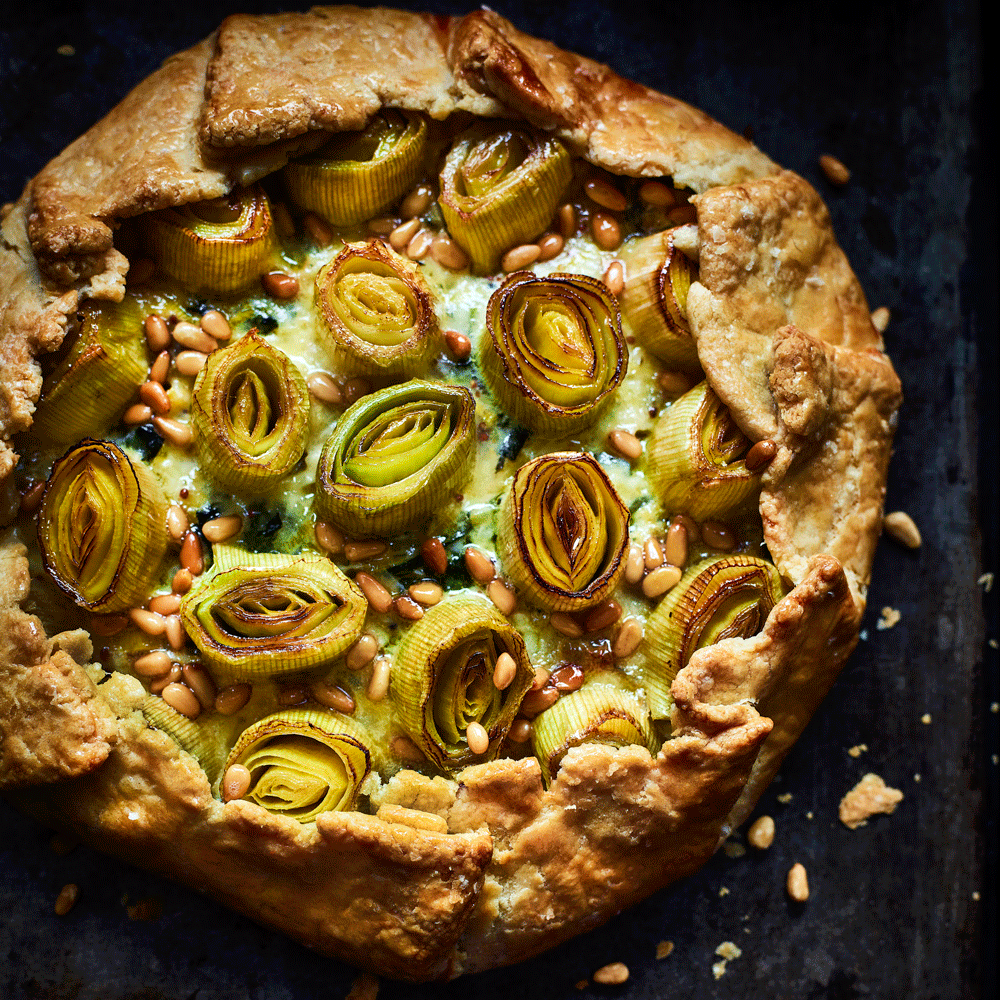
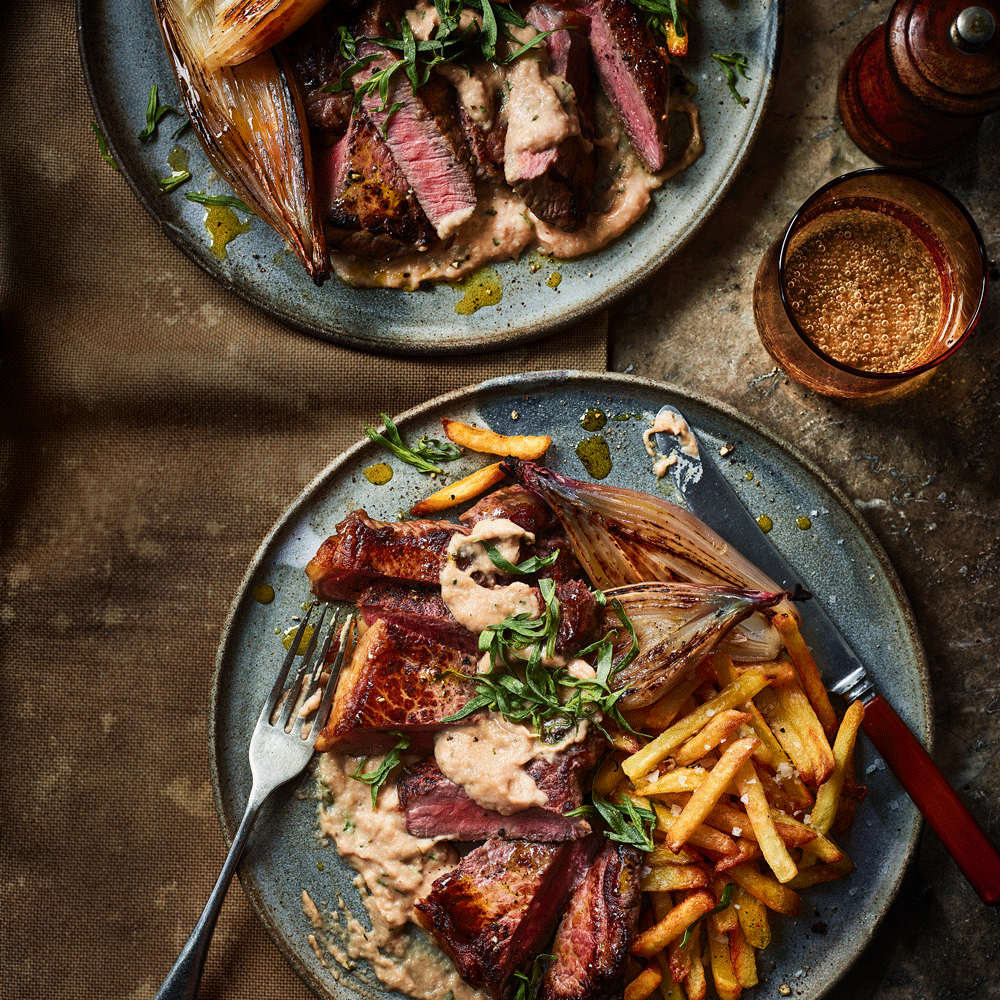
LEEKS
Virtually inedible raw, slow-cooked leeks impart a caramel sweetness to soups, braises and cheesy Glamorgan sausages. Traditionally the darker green parts are saved for the stockpot, but take a case-by-case approach: how slim and how weather-beaten the leeks are will dictate how high up the stem you can go.
Cook’s tip
How to wash leeks The best way to get rid of any residual dirt between the layers of a leek is to roughly chop, put it in a colander, then thoroughly rinse under cold water, using your hands to help get rid of any dirt.
SHALLOTS
Smaller and sweeter than regular onions, shallots migrated from Asia to France in about the 12th century. They’re perhaps at their prettiest in a mignonette dressing for oysters, but sliced thinly and deep fried until crisp they make a particularly successful garnish for soups, salads or savoury traybakes.
Cook’s tip
Echalion vs round shallots Echalions (also known as banana shallots) are a cross between an onion and a shallot. They have the larger size of an onion with the milder flavour of a shallot, and are ideal for roasting alongside joints of meat or charring in a frying pan. Round shallots have a milder flavour, and are better when smaller quantities are needed. Their pretty pink hue makes them perfect for quick pickles or shallow-frying.
Alliums made easy
SHOP NOWShiitake, portobello or oyster? Here’s our handy guide to mushroom varieties”
